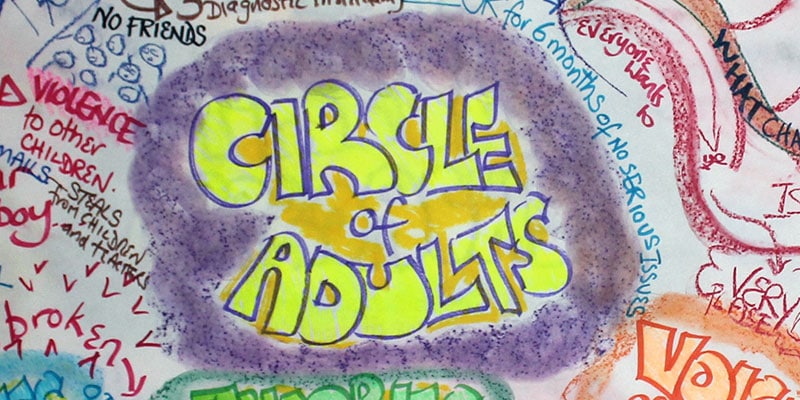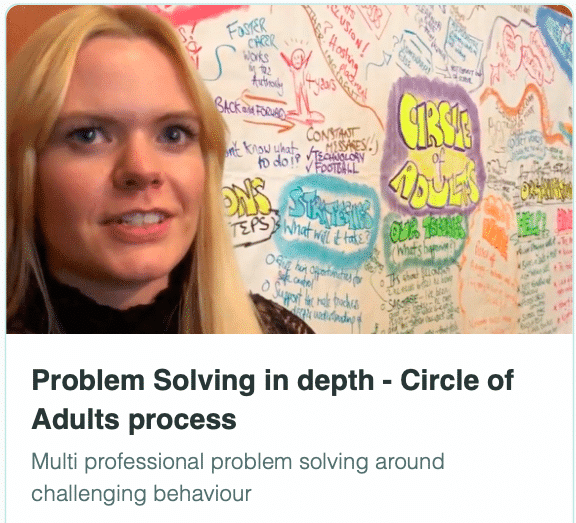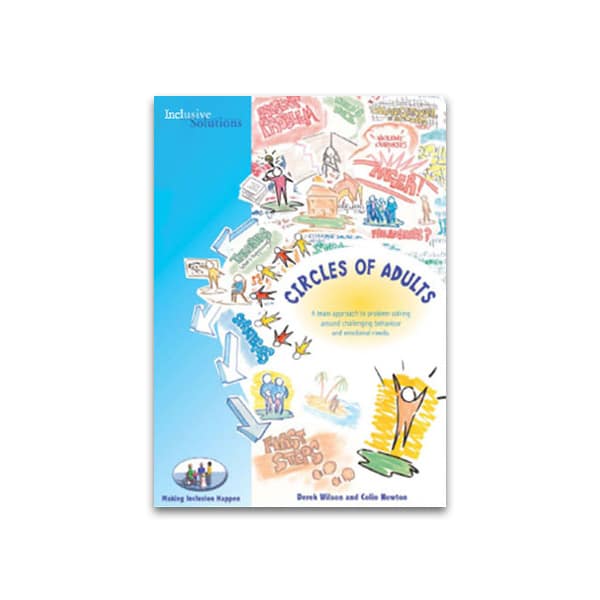
Circles of Adults
Online Course now available via Teachable Platform – Circle of Adults – In depth problem solving Learn at your own pace… lots of text and video support 
|
Course Category
Behaviour and Relationships
Visioning and Problem Solving
Description
‘The question is not should they be here anymore. Now it’s how can we figure out how best to include them?’
In this practical workshop session we will explore ways of problem solving around complex situations. The session will be practical and will aim to allow the sharing of experiences and good practice as well promoting innovative approaches to problem solving around systemic, organisational as well as individual inclusion issues.
Behaviour problems, relationship challenges and personnel dilemmas can all be worked on with these team oriented problem solving processes.
We will introduce participants to a powerful and effective approach.
The ‘Circles of Adults’ approach addresses the need for a problem solving process that is able to take an in-depth look at meeting the emotional needs that commonly underlie challenging behaviour in schools. The approach is co-facilitated and is designed to enable the participation of teacher teams to reach a deeper understanding of a young person and to evolve a set of hypotheses and emerging strategies that better accommodate to unmet emotional and learning needs. The approach takes at least 90 minutes and is intended for use with the most challenging young people, those at high risk of being permanently excluded from the regular school system.
Testimonials
‘A great day – going away buzzing with ideas’
Excellent!
Inspirational!
Informative!
Learning Objectives
- Increased confidence regarding problem solving around inclusion in mainstream settings
- Access to a wider range of practical strategies and techniques to impact on communication, realtionship, learning and behaviour issues
- Learn new problem solving processes
Who Is It For ?
- Educational Psychologists
- Social Workers
- Heads and Deputies
- Guidance staff
- Learning Support teams
- SENCOs
- Primary and secondary teachers
- Parents
- Local Authority Support Services
- Community workers and carers
Course Content
The course answers the questions :
- How to set up and run a Circle of Adults process
- How can we work out how to include this child best?
- How can we understand what lies beneath their behaviour?
- Is there a more structured way to run this meeting?
- Can we explore the emotional impact the person is having on us and still agree strategies?
- How can I get unstuck from this problem?
Step by Step
- Group members are welcomed: and theoretical values and background to the approach are outlined emphasising the importance of inclusive educational opportunities for those with most challenging behaviour, the need for team support and reflection opportunities for front line staff.
- Introductions are made and ground rules and aims are clarified.
- Live issues are gathered from the group: One situation of concern is selected that appears to reflect shared issues.
- Case presentation: The teacher/worker who raised the concern is asked questions to elicit the child’s ‘story’. Key themes are recorded on a large graphic posted where all can see it and take note of the emerging ‘big picture’. The teacher is asked to keep a clear focus on the child and is guided so as not to let their own ‘ideological editor’ allow judgemental thinking or inaccurate generalisations. Positives and negatives about their behaviour are elicited. Feelings are probed – ‘what does it feel like being with this child?
- One member of the group is asked to ‘listen’ to the presentation and subsequent discussions from the perspective of the young person him/herself. From time to the process facilitator asks this member of the group how they are feeling about what they have heard so far.
- Additional questions/information from the group about pupil are gathered from those present
- The process of relationship is described:
- The story of the teacher’s relationship with the young person is described.
- Metaphors and analogies are invited.
- How would a fly on the wall see your relationship?
- If you were alone together on a desert island, what would it be like?
- Impact of previous relationships/spillage from one relationship to another (Transference/Emotional resources explored):
- Teachers are asked who or what situation they are reminded of?
- They are asked whether there has been any transfer of past relationships onto the child or projection of their feelings into the child?
- For instance, does this situation remind you of any of those angry, but helpless feelings you had with your own son when he was and adolescent?
Exploring the child’s possible transference, questions are posed such as:
- is any role being transferred onto teachers by the child?
- For instance, are you being treated as if you were her father?
- Counter transference:
- What feelings actions or thoughts are being used to counter this transference from child to the teacher?
- For instance, are you doing anything to avoid being treated as if you were his parent?
- System/Organisational factors:
- What aspects of the school’s organisation help or hinder this pupil’s emotional/behaviour development?
- What areas of the curriculum provide successful experiences for the child?
- For instance does the pastoral system of the school provide space, or time and skilled personnel able to counsel this young person and work actively with their parents?
- Synthesis of emerging themes by the Graphic facilitator. The content of the graphic so far is summarised and the group’s attention is drawn to emerging themes.
- What understandings/hypotheses can we begin to draw out from the emerging story? This is an important stage and it is essential to keep thinking rich and open ended, inviting as many as possible hypotheses. Participants need to be led through a creative brainstorm of understandings, and theories that might begin to explain what is happening.
- What alternative strategies/interventions are open to be used? Brainstormed and recorded. ‘Either/ors’ need to be avoided at this time also. This needs to be a shared session in which the teacher who is presenting the concern contributes as much as anyone. Care is needed to ensure that this person is not overloaded with other people’s strategies. The problem presenter has final say on strategy selection.
- First Steps agreed. Presenter of the issue then selects the next steps they will pursue and with what strategies. Where possible a ‘coach’ is appointed to check in with the problem presenter that agreed deadlines for completion of first steps are met.
- All stand, form a circle and reflections on the process are shared in the ‘open space’
References
Hanko, Gerda (1999) Increasing Competence through Collaborative Problem Solving David Fulton Publishers, London
Newton, Colin. (1995) Circles of Adults Educational Psychology in Practice, 11(2), pp.8-14.
Sonneman, Milly (1997) Beyond Words – A Guide to Drawing out Ideas Ten Speed Press, California
For a link to the very helpful and informative book ‘Educational Psychology in Practice: theory, research and practice in educational psychology’, click here.

Circles of Adults – Book
Format:
ISBN: 0954635124
Description: Circles of Adults offers the practitioner a 10 step process for facilitating team problem solving around issues of challenging behaviour and emotional needs. Problems are addressed further upstream than conventional approaches to problem solving. Change is targeted at the source of our t…